Chrysler
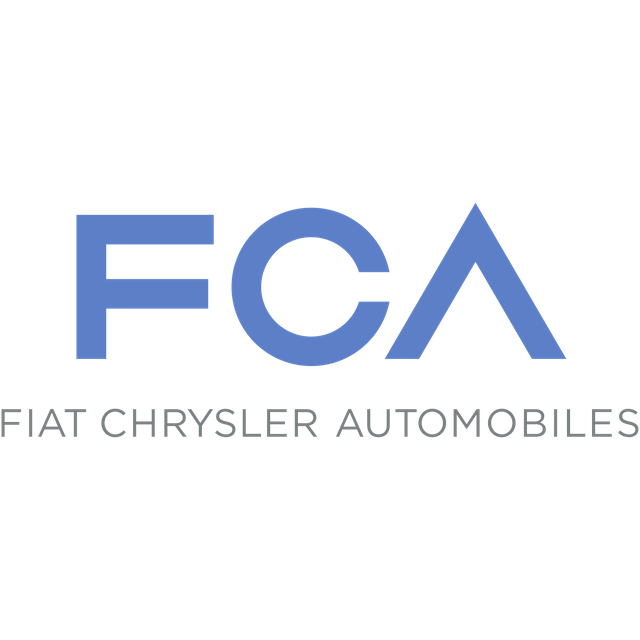
Chrysler

Formerly | Chrysler Corporation (1925–1998) DaimlerChrysler (1998–2007) Chrysler LLC (2007–2009) Chrysler Group LLC (2009–2014) |
|---|---|
Type | |
| Industry | Automotive |
| Predecessors | Maxwell Motor Company United States Motor Company |
| Founded | June 6, 1925 (1925-06-06) |
| Founder | Walter P. Chrysler |
| Headquarters | 1000 Chrysler Drive, Auburn Hills, Metro Detroit, Michigan ,United States |
Number of locations | See List of Chrysler factories |
Area served | Worldwide |
Key people |
|
| Products |
|
| Brands |
|
| Revenue | |
Operating income | |
Net income | |
| Total assets | |
| Total equity | |
Number of employees | 77,817 (2014) |
| Parent | Fiat Chrysler Automobiles |
| Subsidiaries | FCA Canada |
| Website | fcagroup.com [163] |
| Footnotes / references [1] | |
| Product type | Luxury cars |
| Owner | FCA US LLC |
| Country | United States |
| Introduced | June 6, 1925 (1925-06-06) |
| Previous owners | Chrysler Corporation (1925-1998) DaimlerChrysler (1998-2007) Chrysler LLC (2007-2009) Chrysler Group LLC (2009-2014) |
| Website | www.chrysler.com [164] |
Chrysler (/ˈkraɪslər/; officially FCA US LLC, the first acronym standing for Fiat Chrysler Automobiles) is one of the "Big Three" automobile manufacturers in the United States, headquartered in Auburn Hills, Michigan. The original Chrysler Corporation was founded in 1925 by Walter Chrysler from the remains of the Maxwell Motor Company. In 1998, it was acquired by Daimler-Benz, and the holding company was renamed DaimlerChrysler. After Daimler divested Chrysler in 2007, the company existed as Chrysler LLC (2007–2009) and Chrysler Group LLC (2009–2014) before merging in 2014 with Italian holding company Fiat S.p.A. and becoming a subsidiary of its successor Fiat Chrysler Automobiles. In addition to the Chrysler brand, FCA sells vehicles worldwide under the Dodge, Jeep, and Ram nameplates. Furthermore, the subsidiary includes Mopar, its automotive parts and accessories division, and SRT, its performance automobile division.
After founding the company, Walter Chrysler used the General Motors brand diversification and hierarchy strategy that he had seen working for Buick, and acquired Fargo Trucks and Dodge Brothers, and created the Plymouth and DeSoto brands in 1928. Facing postwar declines in market share, productivity, and profitability, as GM and Ford were growing, Chrysler borrowed $250 million in 1954 from Prudential Insurance to pay for expansion and updated car designs.[2][3][4]
Chrysler expanded into Europe by taking control of French, British and Spanish auto companies in the 1960s; Chrysler Europe was sold in 1978 to PSA Peugeot Citroën for $1. The company struggled to adapt to changing markets, increased U.S. import competition, and safety and environmental regulation in the 1970s. It began an engineering partnership with Mitsubishi Motors, and began selling Mitsubishi vehicles branded as Dodge and Plymouth in North America. On the verge of bankruptcy in the late 1970s, it was saved by $1.5 billion in loan guarantees from the U.S. government. New CEO Lee Iacocca was credited with returning the company to profitability in the 1980s. In 1985, Diamond-Star Motors was created, further expanding the Chrysler-Mitsubishi relationship. In 1987, Chrysler acquired American Motors Corporation (AMC), which brought the profitable Jeep brand under the Chrysler umbrella. In 1998, Chrysler merged with German automaker Daimler-Benz to form DaimlerChrysler AG; the merger proved contentious with investors. As a result, Chrysler was sold to Cerberus Capital Management and renamed Chrysler LLC in 2007.
Like the other Big Three automobile manufacturers, Chrysler was impacted by the automotive industry crisis of 2008–2010. The company remained in business through a combination of negotiations with creditors, filing for Chapter 11 bankruptcy reorganization on April 30, 2009, and participating in a bailout from the U.S. government through the Troubled Asset Relief Program. On June 10, 2009, Chrysler emerged from the bankruptcy proceedings with the United Auto Workers pension fund, Fiat S.p.A., and the U.S. and Canadian governments as principal owners. The bankruptcy resulted in Chrysler defaulting on over $4 billion in debts. By May 24, 2011, Chrysler finished repaying its obligations to the U.S. government five years early, although the cost to the American taxpayer was $1.3 billion. Over the next few years, Fiat gradually acquired the other parties' shares while removing much of the weight of the loans (which carried a 21% interest rate) in a short period.
On January 1, 2014, Fiat S.p.A announced a deal to purchase the rest of Chrysler from the United Auto Workers retiree health trust. The deal was completed on January 21, 2014, making Chrysler Group a subsidiary of Fiat S.p.A.[5] In May 2014, Fiat Chrysler Automobiles was established by merging Fiat S.p.A. into the company. This was completed in August 2014. Chrysler Group LLC remained a subsidiary until December 15, 2014, when it was renamed FCA US LLC, to reflect the Fiat-Chrysler merger.[6]
Formerly | Chrysler Corporation (1925–1998) DaimlerChrysler (1998–2007) Chrysler LLC (2007–2009) Chrysler Group LLC (2009–2014) |
|---|---|
Type | |
| Industry | Automotive |
| Predecessors | Maxwell Motor Company United States Motor Company |
| Founded | June 6, 1925 (1925-06-06) |
| Founder | Walter P. Chrysler |
| Headquarters | 1000 Chrysler Drive, Auburn Hills, Metro Detroit, Michigan ,United States |
Number of locations | See List of Chrysler factories |
Area served | Worldwide |
Key people |
|
| Products |
|
| Brands |
|
| Revenue | |
Operating income | |
Net income | |
| Total assets | |
| Total equity | |
Number of employees | 77,817 (2014) |
| Parent | Fiat Chrysler Automobiles |
| Subsidiaries | FCA Canada |
| Website | fcagroup.com [163] |
| Footnotes / references [1] | |
| Product type | Luxury cars |
| Owner | FCA US LLC |
| Country | United States |
| Introduced | June 6, 1925 (1925-06-06) |
| Previous owners | Chrysler Corporation (1925-1998) DaimlerChrysler (1998-2007) Chrysler LLC (2007-2009) Chrysler Group LLC (2009-2014) |
| Website | www.chrysler.com [164] |
History
1925-1998: Chrysler Corporation
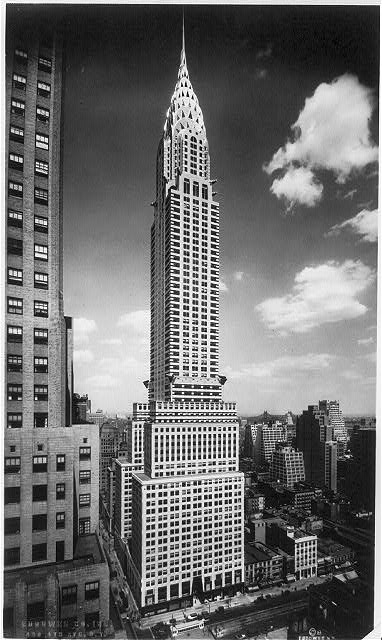
The Art Deco Chrysler Building in New York City was the company headquarters from 1930 until the mid-1950s
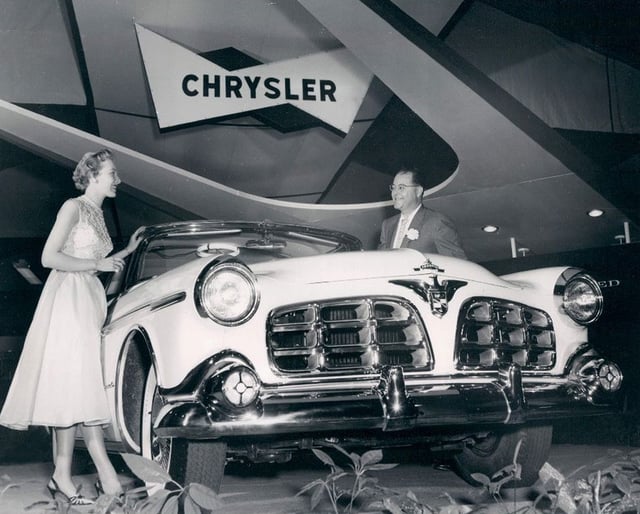
1955 Imperial car model, in its first year as a separate make, apart from Chrysler, shown on display at January 1955 Chicago Auto Show

Chrysler "pentastar" logo, 1962-2014
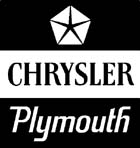
Logo of the Chrysler-Plymouth division of the Chrysler Corporation

In 1987 Chrysler purchased American Motors from Renault
In January 1924, Walter Chrysler launched the well-received Chrysler automobile. The 6-cylinder Chrysler was designed to provide customers with an advanced, well-engineered car, was an automobile at an affordable price. Elements of this car are traceable to a prototype which had been under development at Willys during Chrysler's tenure[12] The original 1924 Chrysler included a carburetor air filter, high compression engine, full pressure lubrication, and an oil filter, features absent from most autos at the time.[13][14] Among the innovations in its early years were the first practical mass-produced four-wheel hydraulic brakes, a system nearly completely engineered by Chrysler with patents assigned to Lockheed, and rubber engine mounts to reduce vibration.
Chrysler also developed a wheel with a ridged rim, designed to keep a deflated tire from flying off the wheel. This wheel was eventually adopted by the auto industry worldwide.
The Maxwell brand was dropped after the 1925 model year, with the new, lower-priced four-cylinder Chryslers introduced for the 1926 year being badge-engineered Maxwells.[12] The advanced engineering and testing that went into Chrysler Corporation cars helped to push the company to the second-place position in U.S. sales by 1936, which it held until 1949.
In 1928, the Chrysler Corporation began dividing its vehicle offerings by price class and function. The Plymouth brand was introduced at the low-priced end of the market (created essentially by once again reworking and rebadging Chrysler's four-cylinder model).[12] At the same time, the DeSoto brand was introduced in the medium-price field. Also in 1928, Chrysler bought the Dodge Brothers[15] automobile and truck company and continued the successful Dodge line of automobiles and Fargo range of trucks. By the mid-1930s, the DeSoto and Dodge divisions would trade places in the corporate hierarchy.
The Imperial name had been used since 1926 but was never a separate make, just the top-of-the-line Chrysler. However, in 1955, the company decided to spin it off as its own make/brand and division to better compete with its rivals, Lincoln and Cadillac.
On April 28, 1955, Chrysler and Philco had announced the development and production of the World's First All-Transistor car radio.[16] The all-transistor car radio, Mopar model 914HR, was developed and produced by Chrysler and Philco, and it was a $150.00 "option" on the 1956 Imperial automobile models. Philco began manufacturing this radio in the fall of 1955 at its Sandusky Ohio plant.[17][18][19]
On September 28, 1957, Chrysler had announced the first production electronic fuel injection (EFI), as an option on some of its new 1958 car models (Chrysler 300D, Dodge D500, DeSoto Adventurer, Plymouth Fury). The first attempt to use this system was by American Motors on the 1957 Rambler Rebel.[20][21] Bendix Corporation's Electrojector used a transistor computer brain modulator box, but teething problems on pre-production cars meant very few cars were made.[22] The EFI system in the Rambler ran fine in warm weather, but suffered hard starting in cooler temperatures and AMC decided not to use this EFI system, on its 1957 Rambler Rebel production cars that were sold to the public.[21] Chrysler also used the Bendix "Electrojector" fuel injection system and only around 35 vehicles were built with this option, on its 1958 production built car models.[23][24] Owners of EFI Chryslers were so dissatisfied that all but one were retrofitted with carburetors (while that one has been completely restored, with original EFI electronic problems resolved).[24]
Imperial would see new body styles introduced every two to three years, all with V8 engines and automatic transmissions, as well as technologies that would filter down to Chrysler corporation's other models. Imperial was folded back into the Chrysler brand in 1971.
The Valiant was also introduced for 1960 as a distinct brand. In the U.S. market, Valiant was made a model in the Plymouth line for 1961 and the DeSoto make was discontinued in 1961. With those exceptions per applicable year and market, Chrysler's range from lowest to highest price from the 1940s through the 1970s was Valiant, Plymouth, Dodge, DeSoto, Chrysler, and Imperial.[25]
From 1963 through 1969, Chrysler increased its existing stakes to take full control of the French Simca, British Rootes and Spanish Barreiros companies, merging them into Chrysler Europe in 1967. In the 1970s, an engineering partnership was established with Mitsubishi Motors, and Chrysler began selling Mitsubishi vehicles branded as Dodge and Plymouth in North America.
Chrysler struggled to adapt to the changing environment of the 1970s. When consumer tastes shifted to smaller cars in the early 1970s, particularly after the 1973 oil crisis, Chrysler could not meet the demand. Additional burdens came from increased US import competition, and tougher government regulation of car safety, fuel economy, and emissions. As the smallest of the Big 3 US automakers, Chrysler lacked the financial resources to meet all of these challenges. In 1978, Lee Iacocca was brought in to turn the company around, and in 1979 Iacocca sought US government help. Congress later passed the Loan Guarantee Act providing $1.5 billion in loan guarantees.[26] The Loan Guarantee Act required that Chrysler also obtain $2 billion in concessions or aid from sources outside the federal government, which included interest rate reductions for $650 million of the savings, asset sales of $300 million, local and state tax concessions of $250 million, and wage reductions of about $590 million along with a $50 million stock offering. $180 million was to come from concessions from dealers and suppliers.[27]
After a period of plant closures and salary cuts agreed to by both management and the auto unions, the loans were repaid with interest in 1983. In November 1983, the Dodge Caravan/Plymouth Voyager was introduced, establishing the minivan as a major category, and initiating Chrysler's return to stability.[27][28]
In 1985, Diamond-Star Motors was created, further expanding the Chrysler-Mitsubishi relationship. In 1987, Chrysler acquired American Motors Corporation (AMC), which brought the profitable Jeep brand under the Chrysler umbrella.
In 1985, Chrysler entered an agreement with AMC to produce Chrysler M platform rear-drive, as well as Dodge Omnis front wheel drive cars, in AMC's Kenosha, Wisconsin plant. In 1987, Chrysler acquired the 47% ownership of AMC that was held by Renault. The remaining outstanding shares of AMC were bought on the NYSE by August 5, 1987, making the deal valued somewhere between US$1.7 billion and US$2 billion, depending on how costs were counted.[29] Chrysler CEO Lee Iacocca wanted the Jeep brand, particularly the Jeep Grand Cherokee (ZJ) that was under development, the new world-class manufacturing plant in Bramalea, Ontario, and AMC's engineering and management talent that became critical for Chrysler's future success.[30] Chrysler established the Jeep/Eagle division as a "specialty" arm to market products distinctly different from the K-car-based products with the Eagle cars targeting import buyers.[31] Former AMC dealers sold Jeep vehicles and various new Eagle models, as well as Chrysler products, strengthening the automaker's retail distribution system.
Eurostar, a joint venture between Chrysler and Steyr-Daimler-Puch, began producing the Chrysler Voyager in Austria for European markets in 1992.
1998-2007: DaimlerChrysler
In 1998, Chrysler and its subsidiaries entered into a partnership dubbed a "merger of equals" with German-based Daimler-Benz AG, creating the combined entity DaimlerChrysler AG.[32] To the surprise of many stockholders, Daimler acquired Chrysler in a stock swap[33] before Chrysler CEO Bob Eaton retired. It is widely accepted that the merger was needed because of Eaton's lack of planning for Chrysler in the 1990s, to become their own global automotive company. Under DaimlerChrysler, the company was named DaimlerChrysler Motors Company LLC, with its U.S. operations generally called "DCX". The Eagle brand was retired soon after Chrysler's merger with Daimler-Benz in 1998[34] Jeep became a stand-alone division, and efforts were made to merge the Chrysler and Jeep brands as one sales unit.[35] In 2001, the Plymouth brand was also discontinued.
Eurostar also built the Chrysler PT Cruiser in 2001 and 2002. The Austrian venture was sold to Magna International in 2002 and became Magna Steyr. The Voyager continued in production until 2007, whereas the Chrysler 300C, Jeep Grand Cherokee and Jeep Commander were also built at the plant from 2005 to 2010.
On May 14, 2007, DaimlerChrysler announced the sale of 80.1% of Chrysler Group to American private equity firm Cerberus Capital Management, L.P., thereafter known as Chrysler LLC, although Daimler (renamed as Daimler AG) continued to hold a 19.9% stake.[36]
2007-2014: Effects of Great Recession
The economic collapse of 2007 - 2009 pushed the fragile company to the brink. On April 30, 2009, the automaker filed for Chapter 11 bankruptcy protection to be able to operate as a going concern, while renegotiating its debt structure and other obligations,[37] which resulted in the corporation defaulting on over $4 billion in secured debts.[37] The U.S. government described the company's action as a "prepackaged surgical bankruptcy".[37]
On June 10, 2009, substantially all of Chrysler's assets were sold to "New Chrysler", organized as Chrysler Group LLC. The federal government provided support for the deal with US$8 billion in financing at near 21%. Under CEO Sergio Marchionne, "World Class Manufacturing" or WCM, a system of thorough manufacturing quality, was introduced and several products re-launched with quality and luxury. The 2010 Jeep Grand Cherokee very soon became the most awarded SUV ever. The Ram, Jeep, Dodge, SRT and Chrysler divisions were separated to focus on their own identity and brand, and 11 major model refreshes occurred in 21 months. The PT Cruiser, Nitro, Liberty and Caliber models (created during DCX) were discontinued. On May 24, 2011, Chrysler repaid its $7.6 billion loans to the United States and Canadian governments.[38][39] The US Treasury, through the Troubled Asset Relief Program (TARP), invested $12.5 billion in Chrysler and recovered $11.2 billion when the company shares were sold in May 2011, resulting in a $1.3 billion loss.[40][41][42][43] On July 21, 2011, Fiat bought the Chrysler shares held by the US Treasury.[44] The purchase made Chrysler foreign-owned again, this time as the luxury division. The Chrysler 300 was badged Lancia Thema in some European markets (with additional engine options), giving Lancia a much needed replacement for its flagship.
2014-present: Fiat Chrysler Automobiles
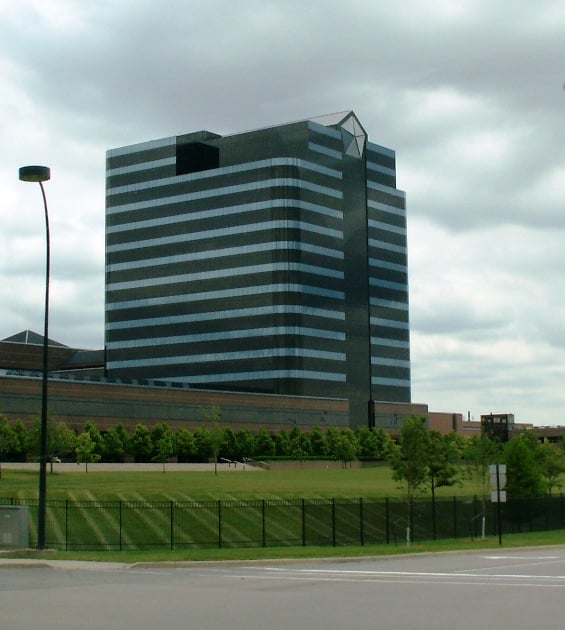
FCA US LLC Headquarters and Technology Center in Auburn Hills, Michigan
On January 21, 2014, Fiat bought the remaining shares of Chrysler owned by the VEBA worth $3.65 billion.[45][5] Several days later, the intended reorganization of Fiat and Chrysler under a new holding company, Fiat Chrysler Automobiles, together with a new FCA logo were announced.[46] The most challenging launch for this new company came immediately in January 2014 with a completely redesigned Chrysler 200. The vehicle's creation is from the completely integrated company, FCA, executing from a global compact-wide platform.[47]
On December 16, 2014, Chrysler Group LLC announced a name change to FCA US LLC.[48]
On January 12, 2017, FCA shares traded at the New York Stock Exchange lost value after the EPA accused FCA US of using emissions cheating software to evade diesel-emissions tests,[49][50][51][52] however the company countered the accusations,[53] and the chairman and CEO Sergio Marchionne sternly rejected them.[54] The following day, shares rose as investors played down the effect of the accusations. Analysts gave estimates of potential fines from several hundred million dollars to $4 billion, although the likelihood of a hefty fine was low.[55] Senior United States Senator Bill Nelson urged the FTC to look into possible deceptive marketing of the company's diesel-powered SUVs. Shares dropped 2.2% after the announcement.[56][57]
On July 21, 2018, Sergio Marchionne stepped down as chairman and CEO for health reasons, and was replaced by John Elkann and Michael Manley, respectively.[58]
As a result of ending domestic production of more fuel-efficient passenger automobiles such as the Dodge Dart and Chrysler 200 sedans, FCA US elected to pay $77 million in fines for violating the anti-backsliding provision of fuel economy standards set under the Energy Independence and Security Act of 2007 for its model year 2016 fleet.[59][60]
As part of a January 2019 settlement, Fiat Chrysler will recall and repair approximately 100,000 automobiles equipped with a 3.0-liter V6 EcoDiesel engine having a prohibited defeat device, pay $311 million in total civil penalties to US regulators and CARB, pay $72.5 million for state civil penalties, implement corporate governance reforms, and pay $33.5 million to mitigate excess pollution. The company will also pay affected consumers up to $280 million and offer extended warranties on such vehicles worth $105 million. The total value of the settlement is worth about $800 million, though FCA did not admit liability, and it did not resolve an ongoing criminal investigation.[61]
Corporate governance
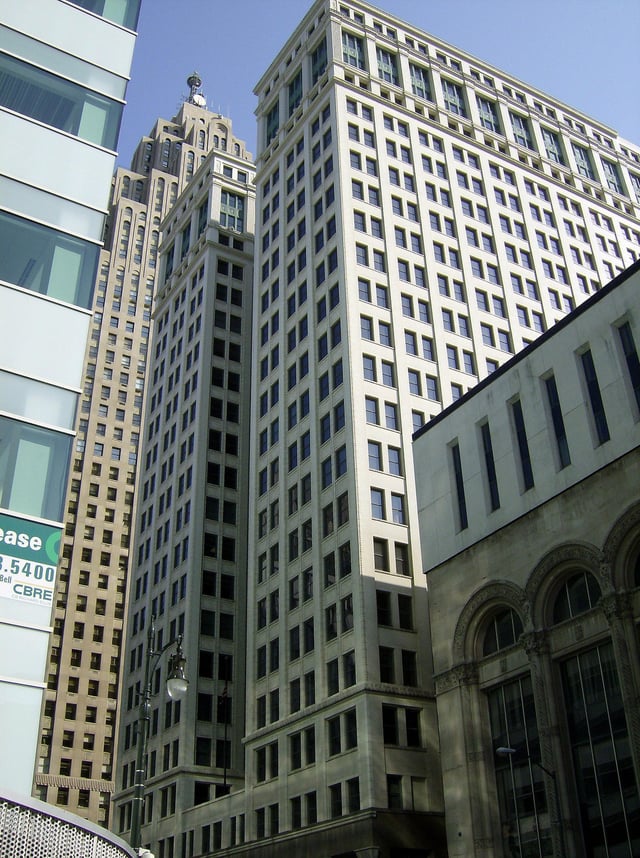
Chrysler House landmark executive offices in the Detroit Financial District
As of 2018, management positions of FCA US include:[62]
Board of directors
Michael Manley, CEO
Reid Bigland
Giorgio Fossati
Michael J. Keegan
Richard Palmer, CFO
Management team
Michael "Mike" Manley: CEO; CEO FCA
Steven Beahm: head of passenger car brands - Dodge, SRT, Chrysler and Fiat, FCA - North America; head of parts and service (Mopar), FCA - North America
Reid Bigland: head of Ram brand; head of US sales; chairman, president and CEO, FCA Canada Inc.
Bruno Cattori: president and CEO, FCA Mexico, S.A. de C.V.
Mark Champine: head of quality - North America
Mark Chernoby: chief technical compliance officer, Fiat Chrysler Automobiles N.V.
Richard Cox: head of portfolio planning, FCA - North America; head of Alfa Romeo and Maserati product planning
Davide Ferina: chief information officer, FCA - North America
Olivier François: chief marketing officer; head of Fiat brand
Alistair "Al" Gardner: head of network development, FCA - North America; head of Maserati - North America
Ralph Gilles: head of design
Niel Golightly: global chief communications officer
Brian Harlow: head of manufacturing, FCA - North America
Philip M. Jansen: head of product development, FCA - North America
Roger "Shane" Karr: head of external affairs, FCA - North America
Michael J. Keegan: chief audit; sustainability and compliance officer
Timothy Kuniskis: global head of Alfa Romeo; head of Jeep brand - North America
João Laranjo: chief financial officer, FCA - North America
Robert "Bob" E. Lee: head of engine, powertrain and electrified propulsion, and systems engineering, FCA - North America; powertrain coordination
Jeffrey P. Lux: head of transmission powertrain, FCA - North America
Douglas Ostermann: head of business development, FCA - North America; treasurer
Chris Pardi: NAFTA general counsel and corporate secretary, FCA US LLC
Barbara J. Pilarski: head of human resources, FCA - North America
Mark Stewart: chief operating officer
Scott Thiele: head of purchasing, FCA - North America; head of supply chain, FCA - North America
Joseph Veltri: head of investor relations
Laurie A. Vitale: head of internal audit and compliance, FCA - North America
Sales and marketing
United States sales
Chrysler is the smallest of the "Big Three" U.S. automakers (FCA US, Ford Motor Company, and General Motors). In 2013 Chrysler sold 1,800,368 vehicles, 9% up from 2012, and fourth largest in sales behind GM, Ford and Toyota.[63]
Chrysler's sales have fluctuated dramatically over the last decade. In 2007 sales reached 2,076,650,[64] falling to 931,402 units in 2009, the company's worst result in decades.
It is reported that Chrysler was heavy on fleet sales in 2010, hitting as high as 56 percent of total sales in February of that year. For the whole year, 38 percent of sales of Chrysler were to fleet customers. The industry average was 19 percent. However, the company hopes to reduce its fleet sales to the industry average in 2011 with a renewed product lineup.[65]
Global sales
Chrysler is the world's 11th largest vehicle manufacturer as ranked by OICA in 2012.[66] Total Chrysler vehicle production was about 2.37 million that year, up from 1.58 million in 2010.
Marketing
Lifetime powertrain warranty
In 2007, Chrysler began to offer vehicle lifetime powertrain warranty for the first registered owner or retail lessee.[67] The deal covered owner or lessee in U.S., Puerto Rico and the Virgin Islands, for 2009 model year vehicles, and 2006, 2007 and 2008 model year vehicles purchased on or after July 26, 2007. Covered vehicles excluded SRT models, Diesel vehicles, Sprinter models, Ram Chassis Cab, Hybrid System components (including transmission), and certain fleet vehicles. The warranty is non-transferable.[68] After Chrysler's restructuring, the warranty program was replaced by five-year/100,000 mile transferrable warranty for 2010 or later vehicles.[69]
"Let's Refuel America"
In 2008, as a response to customer feedback citing the prospect of rising gas prices as a top concern, Chrysler launched the "Let's Refuel America" incentive campaign, which guaranteed new-car buyers a gasoline price of $2.99 for three years.[70] With the U.S. purchase of eligible Chrysler, Jeep, and Dodge vehicles, customers could enroll in the program and receive a gas card that immediately lowers their gas price to $2.99 a gallon, and keeps it there for the three years.
Lancia co-branding
Chrysler plans for Lancia to codevelop products, with some vehicles being shared. Olivier Francois, Lancia's CEO, was appointed to the Chrysler division in October 2009. Francois plans to reestablish the Chrysler brand as an upscale brand.[71]
Ram trucks
In October 2009, Dodge's car and truck lines were separated, with the name "Dodge" being used for cars, minivans and crossovers and "Ram" for light- and medium-duty trucks and other commercial-use vehicles.[72]
| Calendar year | U.S. Chrysler sales | %Chg/yr. |
|---|---|---|
| 1999[73] | 2,638,561 | |
| 2000 | 2,522,695 | |
| 2001[74] | 2,273,208 | |
| 2002[75] | 2,205,446 | |
| 2003 | 2,127,451 | |
| 2004[76] | 2,206,024 | |
| 2005[76] | 2,304,833 | |
| 2006[77] | 2,142,505 | |
| 2007[77] | 2,076,650 | |
| 2008[78] | 1,453,122 | |
| 2009[79] | 931,402 | |
| 2010[80] | 1,085,211 | |
| 2011[81] | 1,369,114 | |
| 2012[82] | 1,651,787 | |
| 2013[83] | 1,800,368 | |
| 2014[84] | 2,090,639 | |
| 2015[85] | 2,243,907 | |
| 2016[86] | 2,244,315 | |
| 2017[87] | 2,059,376 | |
| 2018[88] | 2,235,204 |
"Imported From Detroit"
In 2011, Chrysler unveiled their "Imported From Detroit" campaign with ads featuring Detroit rapper Eminem, one of which aired during the Super Bowl. The campaign highlighted the rejuvenation of the entire product lineup, which included the new, redesigned and repackaged 2011 200 sedan and 200 convertible, the Chrysler 300 sedan and the Chrysler Town & Country minivan.[89][90] As part of the campaign, Chrysler sold a line of clothing items featuring the Monument to Joe Louis, with proceeds being funneled to Detroit-area charities, including the Boys and Girls Clubs of Southeast Michigan, Habitat for Humanity Detroit and the Marshall Mathers Foundation.[91] Following the Eminem ad, there was also an ad for Detroit Lions defensive tackle Ndamukong Suh driving a Chrysler 300 to Portland, Oregon, to visit his mother, an ad featuring Detroit-born fashion designer John Varvatos cruising through a shadowy Gotham while Kevin Yon's familiar baritone traces the designer's genesis.[92]
In March 2011, Chrysler Group LLC filed a lawsuit against Moda Group LLC (owner of Pure Detroit clothing retailer) for copying and selling merchandise with the "Imported from Detroit" slogan.[93] Chrysler claimed it had notified defendant of its pending trademark application February 14, but the defendant argued Chrysler had not secured a trademark for the "Imported From Detroit" phrase. On June 18, 2011, U.S. District Judge Arthur Tarnow ruled that Chrysler's request did not show that it would suffer irreparable harm or that it had a strong likelihood of winning its case. Therefore, Pure Detroit's owner, Detroit retailer Moda Group LLC, can continue selling its "Imported from Detroit" products. Tarnow also noted that Chrysler does not have a trademark on "Imported from Detroit" and rejected the automaker's argument that trademark law is not applicable to the case.[94][95] In March 2012, Chrysler Group LLC and Pure Detroit agreed to a March 27 mediation to try to settle the lawsuit over the clothing company's use of "Imported from Detroit" slogan.[96] Pure Detroit stated that Chrysler has made false claims about the origins of three vehicles - Chrysler 200, Chrysler 300 and Chrysler Town & Country - none of which are built in Detroit. Pure Detroit also said that Chrysler's Imported From Detroit merchandise is not being made in Detroit. In 2012 Chrysler and Pure Detroit came to an undisclosed settlement.[97]
Chrysler's Jefferson North Assembly, which makes the Jeep Grand Cherokee and Dodge Durango, is the only car manufacturing plant of any company remaining entirely in Detroit (General Motors operates a plant which is partly in Detroit and partly in Hamtramck).[98]
In 2011, Eminem settled a lawsuit against Audi alleging the defendant had ripped off the Chrysler 300 Super Bowl commercial in the Audi A6 Avant ad.[99]
"Half Time in America"
Again in 2012, Chrysler advertised during the Super Bowl. Its two-minute February 5, 2012 Super Bowl XLVI advertisement was titled "Half Time in America". The ad drew criticism from several leading U.S. conservatives, who suggested that its messaging implied that President Barack Obama deserved a second term and, as such, was political payback for Obama's support for the federal bailout of the company.[100] Asked about the criticism in a 60 Minutes interview with Steve Kroft, Sergio Marchionne responded "just to rectify the record I paid back the loans at 19.7% Interest. I don't think I committed to do to a commercial on top of that" and characterized the Republican reaction as "unnecessary and out of place".[101]
- "America's Import"
In 2014, Chrysler started using a new slogan, "America's Import" in ads introducing their all-new 2015 Chrysler 200,[102] targeting foreign automakers from Germany to Japan with such ads (German performance and Japanese quality), and at the ending of selected ads, the advertisement will say, "We Built This", indicating being built in America, instead of overseas.
Slogans
Product line
Current brands
Chrysler: Luxury sedans and minivans
Dodge: Passenger, performance cars, minivans, crossovers and SUVs
Jeep: Off-road vehicles, SUVs and crossovers
Ram: Trucks and commercial vehicles
Mopar
Mopar: Replacement parts for Chrysler-built vehicles, as well as a brand for dealer service and customer service operations. Mopar Performance: a subdivision providing performance aftermarket parts for Chrysler-built vehicles.
Chrysler Uconnect
First introduced as MyGig, Chrysler Uconnect is a system that brings interactive ability to the in-car radio and telemetric-like controls to car settings.[106] As of mid-2015, it is installed in hundreds of thousands of Fiat Chrysler vehicles.[107] It connects to the Internet via the mobile network of AT&T, providing the car with its own IP address.[107] Internet connectivity using any Chrysler, Dodge, Jeep or Ram vehicle, via a Wi-Fi "hot-spot", is also available via Uconnect Web. According to Chrysler LLC, the hotspot range extends approximately 100 feet (30 m) from the vehicle in all directions, and combines both Wi-Fi and Sprint's 3G cellular connectivity. Uconnect is available on several current and was available on several discontinued Chrysler models including the current Dodge Dart, Chrysler 300, Aspen, Sebring, Town and Country, Dodge Avenger, Caliber, Grand Caravan, Challenger, Charger, Journey, Nitro, and Ram.[108]
In July 2015, IT security researchers announced a severe security flaw assumed to affect every Chrysler vehicle with Uconnect produced from late 2013 to early 2015.[107] It allows hackers to gain access to the car over the Internet, and in the case of a Jeep Cherokee was demonstrated to enable an attacker to take control not just of the radio, A/C, and windshield wipers, but also of the car's steering, brakes and transmission.[107] Chrysler published a patch that car owners can download and install via a USB stick, or have a car dealer install for them.[107]
Former brands
Chrysler Europe (sold to Peugeot) Rootes Group, UK Sunbeam (1901–1976), UK Humber (1898–1976), UK Singer (1905–1970), UK Commer (1905–1979), UK Hillman (1907–1976), UK Karrier (1908–1977), UK Talbot (1903-1958),(1979-1994),UK Simca (1934–1977), France Barreiros (1959–1978), Spain
American Motors Corporation (AMC) (1954–1988), US Hudson (1909–1957), US Nash (1917–1957), US Rambler (1900–1914; 1950–1969), US Metropolitan (1959-1962),US[109] Willys-Overland (1908-1963) acquired by Kaiser Motors, later Kaiser Jeep, then by AMC in 1970 Graham-Paige (1927-1947),acquired by Kaiser Kaiser (1946-1955)[110][111][112] Frazer(1946-1951)
Graham Brothers (1916–1929), acquired by Dodge Brothers in 1926
Maxwell (1904–1926), US
Chalmers (1908-1923) Merged with Maxwell 1922.
Fargo (1920–1972), Canada
DeSoto (1928–1961), US-Brand discontinued and replaced by the Chrysler Newport.
Plymouth (1928–2001), US-Merged with Chrysler
Imperial (1955–1975; 1981–1983), US- Merged back into the Chrysler brand.
Valiant (1960–1976) The Valiant was introduced in 1960 as a separate Chrysler brand, then was incorporated into the Plymouth line in the US starting in 1961. Valiant (1962–1981), Australia Valiant (1960–1966) Chrysler marketed the Valiant as a separate Chrysler model in Canada until 1967, when the Canada–United States Automotive Products Agreement of 1965 facilitated the sale of American-built Plymouth Valiants in Canada.
Eagle (1988–1998), US
GEMCAR (1998–2011) sold to Polaris Industries, US
SRT (2012–2014). Merged with Dodge, US
Lamborghini (1987-1994) Sold to Malaysian investment group Mycom Setdco and Indonesian group V'Power Corporation.
Chrysler Marine (1927-1980)[113] US A Division Chrysler that built Inboard,outboard engines and various types of boats.
Chrysler-Airtemp (1934-1976)
Chrysler brand
The Chrysler brand has mostly been Chrysler's premium brand competing with brands such as Cadillac, Packard, Cord and Lincoln. After the corporation decided to spin Imperial off as a separate brand in 1955 to better compete with Cadillac and Lincoln, Chrysler became the corporation's number two brand, but still offered luxury and near-luxury products. After the Imperial brand was dropped in 1975, Chrysler once again became the top brand.
The Chrysler Town & Country is a station wagon that was manufactured by Chrysler from 1940 to 1942 and from 1945 to 1988 (there was no production during World War II from 1943 to 1945). The Town & Country was also available in four-door sedan, two-door hardtop (no "B" pillar), and convertible body styles from 1947 to 1950 and from 1983 to 1986. The 1988 model year was the last for the Chrysler Town & Country station wagon, after that and partly during one model year (1989), the Town & Country nameplate was off the market until the 1990 model year run when Chrysler re-introduced the Town & Country nameplate as a rebadged variant Chrysler Town & Country minivan.
Chrysler's Town & Country wagon was reintroduced as a four door station wagon of all steel construction in 1951. It was offered in both Windsor and New Yorker variants through the end of Windsor model production after the 1960 model year, and then in Newport and New Yorker models through 1965. After that, it was a model in its own right, with trim and features which bridged the gap between the two sedan lines. It was distinguished by luxury features including a carpeted loadfloor trimmed with chrome strips, and from 1968 forward, woodgrain paneling on the body sides and tailgate, a feature also associated with somewhat competitive top-shelf station wagons such as the AMC Ambassador, Buick Estate, Oldsmobile Custom Cruiser, Ford Country Squire, and the Mercury Colony Park. Town and Country, however, stood in a class by itself until the last of the full-sized versions of 1977. From 1978, it was sized down and absorbed into the LeBaron series, with a lesser version lacking the more luxurious features and the woodgrain bodyside decals available for a few years in the early 1980s.
Chrysler re-introduced the Town & Country nameplate in calendar year 1989 as a luxury rebadged variant of the Dodge Grand Caravan/Plymouth Grand Voyager minivan for the 1990 model year and continued to sell this incarnation of the Chrysler Town & Country until the end of the 2016 model year when Chrysler reintroduced the Pacifica nameplate for their minivan in calendar year 2016 for the 2017 model year run.
1950s
Chrysler introduced their first overhead-valve, high-compression V8 engine in 1951, Displacing 331 cubic inches, it was rated at 180 bhp, 20 more hoursepower than the new-for-1949 Cadillac V8. It was unique as the only American V8 engine designed with hemispherical combustion chambers. After successfully winning Mexican Road Races, the engine was upgraded to 250 bhp by 1955. Although Chrysler didn't have the capital to build a small sporty car (such as the Chevrolet Corvette and the Ford Thunderbird), they decided to build a unique sporting car based on the New Yorker hardtop coupe, that featured a 300-bhp "Hemi" V8. To add to the car's uniqueness, the car was given a grille from the Imperial, and side trim from the less-adorned Windsor. A PowerFlite 2-speed automatic transmission was the only available gearbox. It was marketed as the Chrysler 300, emphasizing the engine's horsepower.
A 1955 restyle by newly-hired Virgil Exner saw a dramatic rise in Chrysler sales, which rose even more in 1957, when the entire line was dramatically restyled a second time with a sloping front end and high-flying tailfins at the rear. Although well-received at first, it soon became apparent that quality control was compromised to get the new cars to market on an accelerated schedule. Sales therefore plummeted in 1958 and 1959 despite improvements in quality. Throughout the mid- and late-1950s, Chryslers were available in top-line New Yorker, mid-line Saratoga, and base Windsor series. Exner's designs for the Chrysler brand in the early 1960s were overblown versions of the late 1950s, which were unhelpful in sales. Exner left his post by 1962, leaving Elwood Engel, a recent transfer from Ford Motor Co, in charge of Chrysler styling.
1960s
Although early 1960s Chrysler cars reflected Virgil Exner's exaggerated styling, ELwood Engel's influence was evident as early as 1963, when a restyled, trimmer, boxier Chrysler was introduced. The Windsor and Saratoga series were replaced with the Newport, while New Yorker continued as the top-of-the-line. The Chrysler 300, officially part of the New York line, continued in production through 1965, adding a different letter of the alphabet for each year of production, starting with the 300-B of 1956, through the 300-L of 1965. 1962 saw a "non-letter" 300 which was lower in price but was equipped with downgraded standard equipment. The '65 Chryslers were again dramatically restyled, with a thoroughly modern unit body and larger engines up to 440 cubic inches. They were trim and boxy, with glass-covered headlamps and a swept-back roofline for 2-door hardtop models. a Although Chryslers though the 1960s were well-built, quality cars with man innovative features (such as unit bodies and front torsion bar suspension), sales slumped as American buyers bought record numbers of cars from Ford and GM.
1970s
The Cordoba was introduced by Chrysler for the 1975 model year as an upscale personal luxury car, competing with the Oldsmobile Cutlass, Buick Regal, and Mercury Cougar. The Cordoba was originally intended to be a Plymouth—the names Mirada, Premier, Sebring, and Grand Era were associated with the project; all except Grand Era would be used on later Chrysler, Dodge, and Eagle vehicles, though only the Dodge Mirada would be related to the Cordoba. However, losses from the newly introduced full-size C-body models due to the 1973 oil crisis encouraged Chrysler executives to seek higher profits by marketing the model under the more upscale Chrysler brand.
The car was a success, with over 150,000 examples sold in 1975, a sales year that was otherwise dismal for the company. Gauges, except the tachometer, were standard.[114] For the 1976 model year, sales increased slightly to 165,000. The mildly revised 1977 version also sold well, with just under 140,000 cars. The success of using the Chrysler nameplate strategy is contrasted to sales of its similar and somewhat cheaper corporate cousin, the Dodge Charger SE.[115]
Interiors were more luxurious than the Dodge Charger SE and much more than the top-line standard intermediates (Plymouth Fury, Dodge Coronet) with a velour cloth notchback bench seat and folding armrest standard. Optionally available were bucket seats upholstered in Corinthian leather with a center armrest and cushion, or at extra cost, a center console with floor shifter and storage compartment. The dashboard and door panels featured simulated burled elm trim and metal stampings in 1975, while 1976–1979 models featured simulated rosewood trim. A 60/40 bench seat was introduced in 1976 and other seating/upholstery options were added each year through 1979.
1980s
The early 1980s Imperial was an attempt to reinvent the Imperial as a personal luxury car. This came about after Lee Iacocca took the helm at Chrysler, as he had been instrumental in creating the successful Continental Mark series for this market while he was at Ford in the late 1960s. Although the company was facing bankruptcy, Iacocca decided that "a new flagship would assure the public that Chrysler had a future."[116] During the design of the car it was intended to be named Chrysler LaScala.[117] However, when the car finally appeared, it was marketed simply as an Imperial, and the Chrysler name was not used.[118]
For 1982, the LeBaron moved to the front-wheel drive Chrysler K platform, where it was the upscale brand's lowest priced offering. It was initially available in just sedan and coupe versions. In early 1982, it was released in a convertible version, bringing to the market the first factory-built open-topped domestic vehicle since the 1976 Cadillac Eldorado. A station wagon version called the Town and Country was added as well. A special Town and Country convertible was also made from 1983 to 1986 in limited quantities (1,105 total), which like the wagon featured simulated wood paneling that made it resemble the original 1940s Town and Country. This model was part of the well-equipped Mark Cross option package for the latter years.
In 1982 the R-body line was discontinued and the New Yorker nameplate transferred to the smaller M-body line. Up to this point, the Chrysler M-body entry had been sold as LeBaron, but that name was moved to a new K-car based FWD line (refer to the Chrysler LeBaron article for information on the 1977-81 M-bodies). Following the nameplate swap, the M-body line was consolidated and simplified. 360 V8 engines were gone, as were coupes and station wagons (the K-car LeBaron's coupe and wagon replaced them).
The Fifth Avenue option was still available as a $1,244 option package. It was adapted from the earlier LeBaron's package, with a distinctive vinyl roof, electro-luminescent opera lamps, and a rear fascia adapted from the Dodge Diplomat, albeit modified. Interiors featured button-tufted, pillow-soft seats covered in either "Kimberley velvet" or "Corinthian leather", choices that would continue unchanged throughout the car's run. In addition, the carpet was thicker than that offered in the base New Yorker, Diplomat and Gran Fury/Caravelle Salon, and the interior had more chrome trim. The Fifth Avenue option also included illuminated entry, AM/FM stereo with a rear amplifier, power door locks, power 6-way driver's seat, power antenna, remote trunk release, dual side mirrors, full undercoating, passenger vanity mirror, tape stripes, locking wire wheel covers, as well as a standard 5.2L (318 in³) V8 engine.
For 1984 the car was simply called Fifth Avenue, setting the name that would continue for six successful years. The Fifth Avenue (and its Dodge and Plymouth siblings) would prove to be the last V8-powered, rear wheel drive Chrysler vehicles until the Chrysler 300 was revived in that configuration for 2005.
All Fifth Avenues from 1984 to 1989 were powered by a 5.2 L (318 in³) V8 engine, with either a two barrel carburetor making 140 hp (104 kW) (in all states except California) or a four barrel rated at 170 hp (127 kW) (in California), mated to Chrysler's well-known Torqueflite three speed automatic transmission. As this was the largest Chrysler model available, sales took off, especially during 1985-86, when over 100,000 were made each year.
Starting with the 1984 models, Fifth Avenue production was moved from Windsor, Ontario to St. Louis, Missouri. Beginning in late 1986 through the 1989 model year, they were manufactured at the American Motors plant in Kenosha, Wisconsin (purchased by Chrysler in 1987). The Fifth Avenue also far outsold its Dodge Diplomat and Plymouth Gran Fury siblings, with a much greater proportion of sales going to private customers, despite its higher price tag.[119] Production peaked at 118,000 cars for 1986 and the Fifth Avenue stood out in a by-now K-car dominated lineup as Chrysler's lone concession to traditional RWD American sedans.
1990s
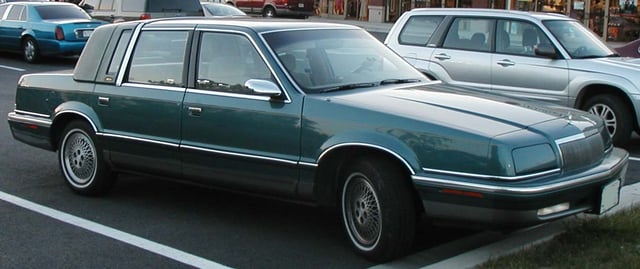
1992–1993 Chrysler New Yorker Fifth Avenue
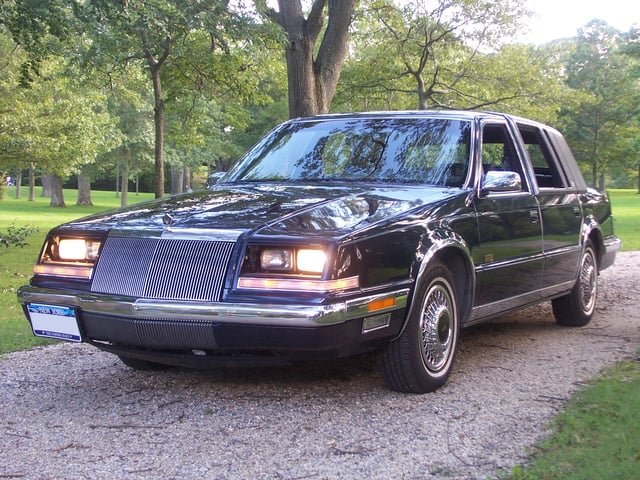
1992 Chrysler Imperial
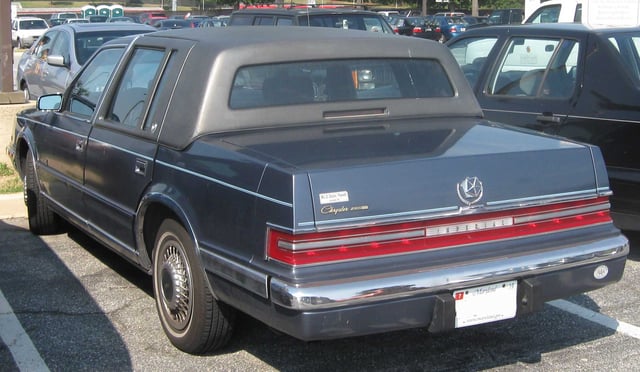
The 1990s Chrysler Imperial featured full-width taillights
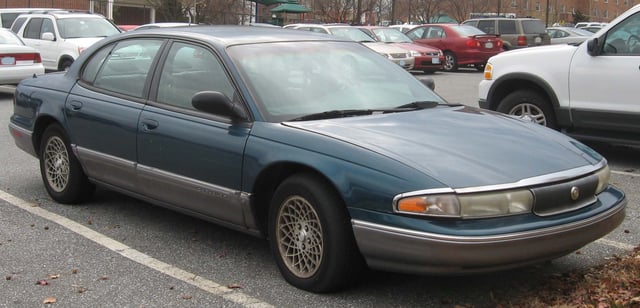
1994–1996 Chrysler New Yorker
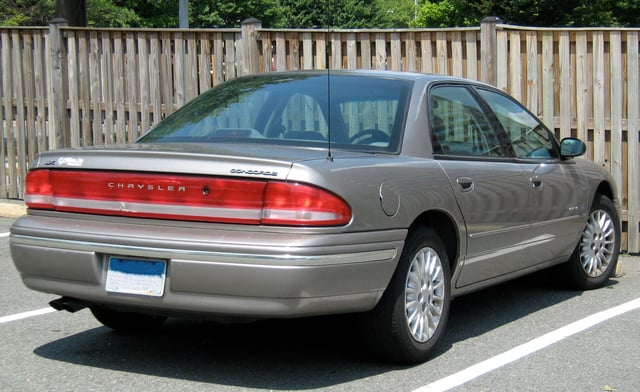
First generation featured full width taillamp design
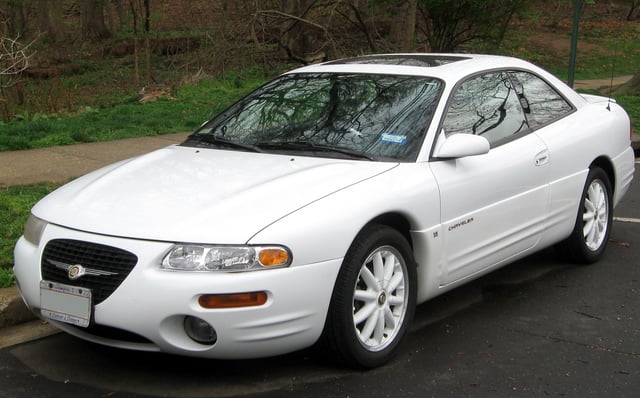
1997–2000 Chrysler Sebring coupe
Chrysler re-introduced the Town & Country nameplate in calendar year 1989 as a luxury rebadged variant of the Dodge Grand Caravan/Plymouth Grand Voyager minivan for the 1990 model year and continued to sell this incarnation of the Chrysler Town & Country until the end of the 2016 model year when Chrysler reintroduced the Pacifica nameplate for their minivan in calendar year 2016 for the 2017 model year run. 1990 saw the previous relationship between New Yorker and Fifth Avenue return, as the Fifth Avenue became a model of the New Yorker. There was some substantive difference, however, as the New Yorker Fifth Avenue used a slightly longer chassis than the standard car. The new New Yorker Fifth Avenue's larger interior volume classified it as a full-size model this time; despite having smaller exterior dimensions than the first generation. 1990 also saw the return of hidden headlamps which when off were concealed behind retractable metal covers. Hidden headlamps had not been available since the 1981 R-body New Yorker Fifth Avenue. For 1990, Chrysler's new 3.3-liter V6 engine was the standard and only choice, teamed with the company's A-604 four-speed electronic automatic transaxle. Beginning in 1991, a larger 3.8-liter V-6 became optional. It delivered the same 147 horsepower as the 3.3, but had more torque.
The New Yorker Fifth Avenue's famous seats, long noted for their button-tufted appearance and sofa-like comfort, continued to be offered with the customer's choice of velour or leather, with the former "Corinthian leather" replaced by that of the Mark Cross company. Leather-equipped cars bore the Mark Cross logo on the seats and, externally, on an emblem attached to the brushed aluminum band ahead of the rear door opera windows. In this form, the New Yorker Fifth Avenue resembled the newly revived Chrysler Imperial, although some much-needed distinction was provided between the cars when the New Yorker Fifth Avenue (along with its New Yorker Salon linemate) received restyled, rounded-off front and rear ends for the 1992 model year, while the Imperial continued in its original crisply-lined form.
The early 1990s saw a revival of the Imperial as a high-end sedan in Chrysler’s lineup.[120] Unlike the 1955–1983 Imperial, this car was a model of Chrysler, not its own marque. Based on the Y platform, it represented the top full-size model in Chrysler's lineup; below it was the similar New Yorker Fifth Avenue, and below that was the shorter wheelbase New Yorker.
The reintroduction of the Imperial was two years after the Lincoln Continental was changed to a front-wheel drive sedan with a V6 engine. Other domestic competitors in this segment included the Cadillac Sedan de Ville/Fleetwood, Oldsmobile 98 and Buick Electra/Park Avenue, all of which shared General Motors' then-flagship C platform.
Though closely related, the Imperial differed from the New Yorker Fifth Avenue in many ways. The Imperial's nose was more wedge-shaped, while the New Yorker Fifth Avenue's had a sharper, more angular profile (the New Yorker Fifth Avenue was later restyled with a more rounded front end). The rears of the two cars also differed. Like the front, the New Yorker Fifth Avenue's rear came to stiffer angles while the Imperial's rear-end came to more rounded edges. Also found on the Imperial were full-width taillights which were similar to those of the Chrysler TC, as well as the early 1980s Imperial coupe, while the New Yorker Fifth Avenue came with smaller vertical taillights. On the inside, the Imperial's "Kimberly Velvet" (Mark Cross Leather was available) seats carried a more streamlined look, while the New Yorker Fifth Avenue came with its signature pillowy button-tufted seats.
Initially, the 1990 Imperial was powered by the 147 hp (110 kW) 3.3 L EGA V6 engine, which was rated at 185 lb⋅ft (251 N⋅m) of torque. For 1991, the 3.3 L V6 was replaced by the larger 3.8 L EGH V6.[121] Although horsepower only increased to 150 hp (112 kW), with the new larger 3.8 L V6 torque increased to 215 lb⋅ft (292 N⋅m) at 2750 rpm. A four-speed automatic transmission was standard with both engines.
This generation Imperial was a 6-passenger sedan offered in either velour or Mark Cross leather. Power equipment came standard, as did automatic climate controlled air conditioning, anti-lock brakes, cruise control, driver's side airbag, and its distinct landau vinyl roof. The Imperial featured hidden headlamps behind retractable metal covers similar to those found on the LeBaron coupe/convertible and New Yorker/Fifth Avenue. The Imperial was available with a choice of several Infinity sound systems, all with a cassette player. Other major options included fully electronic digital instrument cluster with information center, electronically controlled air suspension system, and remote keyless entry with security alarm. Dealer-installed integrated Chrysler cellular phones and six-disc CD changers were also available.
Introduced in May 1993 for the 1994 model year, the Chrysler LHS was the top of the line model for the division, as well as the most expensive of the Chrysler LH platform cars.[122] All the LH-series models shared a 113.0-inch (2,870 mm) wheelbase and were developed using Chrysler's new computer drafting system.[123]
The car was differentiated from the division's New Yorker sedan by its bucket leather seats (the New Yorker had a bench seat) and standard features such as alloy wheels that were options on the New Yorker.[124] Further differences between the Chrysler LHS and its New Yorker counterpart were a floor console and shifter, five-passenger seating, lack of chrome trim, an upgraded interior and a sportier image. From the 1996 model year on the New Yorker was dropped in favor of a six-passenger option on the LHS. The LHS received a minor face change in 1995 when the corporate wide pentastar emblem was replaced with the revived Chrysler brand emblem. Standard features of the LHS included a 3.5 L EGE 24-valve 214 hp (160 kW; 217 PS) V6 engine, body-colored grille, side mirrors and trim, traction control, aluminum wheels, integrated fog lights, 8-way power adjustable front seats, premium sound systems with amplifiers, and automatic temperature control. Unlike the New Yorker, leather seats were standard.
The final generation of the New Yorker continued with front-wheel drive on an elongated version of the new Chrysler LH platform and was shown at the 1992 North American International Auto Show in Detroit. It was released in May 1993 along with the nearly identical Chrysler LHS as an early 1994 model, eight months after the original LH cars: the Chrysler Concorde, Dodge Intrepid, and Eagle Vision, were introduced. The New Yorker came standard with the 3.5 L EGE which produced 214 hp (160 kW). Chrysler gave the New Yorker a more "traditional American" luxury image, and the LHS a more European performance image (as was done with the Eagle Vision). Little separated New Yorker from LHS in appearance, with New Yorker's chrome hood trim, body-color cladding, standard chrome wheel covers and 15" wheels, column shifter and front bench seat, being the only noticeable differences. An option provided for 16" wheels and a firmer suspension type ("touring suspension"). This option eliminated the technical differences between New Yorker and LHS. LHS came with almost all of New Yorker's optional features as standard equipment and featured the firmer tuned suspension, to go with its more European image.
During the 1994 model run, various changes were made to the New Yorker. On the outside, New Yorker was switched to new accent-color body cladding, whereas LHS received body-color cladding. This change aligned New Yorker with the Chrysler Concorde which also had accent-color cladding. Instead of standard 15" and optional 16" wheels, for the sake of enhanced stability 16" wheels became standard and the 15" wheels were dropped. Likewise, the touring suspension option available on early 1994 New Yorker models was discontinued, leaving only "ride-tuned" suspension. This resulted in a permanent technical difference with the LHS.
Out of all the LH sedans, the first generation Concorde was most closely related to the Eagle Vision. The Concorde was given a more traditional image than the Vision. The two shared nearly all sheetmetal in common with the main differences limited to their grilles, rear fascias, body side moldings, and wheel choices. The Concorde featured a modern take on Chrysler's signature waterfall grille. It was split into six sections divided by body colored strips with the Chrysler Pentastar logo on the center strip. The Concorde's rear fascia was highlighted by a full-width and full-height lightbar between the taillights, giving the appearance that the taillights stretched across the entire trunk. In keeping with its upscale position, Concorde's body side moldings incorporated bright chrome (later golden colored) work not found on its Dodge or Eagle siblings. On Concordes with gray lower body paint color, the gray came all the way up to the chrome beltline; on Visions the gray lower body paint area was smaller and much more subtle. Wheel styles, which included available aluminum wheels with a Spiralcast design, were also unique to the Chrysler LH sedans (Concorde, LHS, New Yorker); Dodge and Eagle had their own different wheel styles.
2010s
Following FCA's acquisition of Chrysler, FCA set a long-term goal of reviving the Chrysler brand as a full luxury brand to compete again with Cadillac and other luxury brands.[126] The company stated in October 2009 that future plans for Chrysler brand vehicles include closer cooperation and shared development between Chrysler and Lancia, an upscale Italian automaker within the Fiat Group.[127] In 2011, the brand's winged emblem was modified, eliminating the historic blue ribbon center which dated from the 1930s, replacing it with a blue-backed "Chrysler" nameplate. In May 2014, FCA announced it would make the brand a mainstream brand with premium features.[128]
The brand's current lineup consist of the Chrysler 300 and the Chrysler Pacifica.[129]
Fiat
In 2010, Fiat Auto was planning to sell seven of its vehicles in the U.S. by 2014, while Fiat-controlled Chrysler Group was to supply nine models to sell under Fiat brands in the European market, according to a five-year plan rolled out on April 21, 2010 in Turin, Italy, by Fiat and Chrysler CEO Sergio Marchionne. At least five of the Fiat Auto models were expected to be marketed in the U.S. under its Alfa Romeo brand. Showing the level of integration envisioned, a product introduction timeline envisaged Chrysler-built compact and full-size SUVs going on sale in 2012 and 2014, respectively, in both European and North American markets.[130]
Reception
Chrysler's quality and customer satisfaction ratings have been below average according to Consumer Reports and JD Powers since the late 1990s.[131][132][133] Consumer Reports has consistently reported Chrysler brands at the bottom of their reliability ratings in the past decade as well as their Automotive Brand Report Card.[134][135][136][137] JDP has found similar results over the same time period in both Initial Quality Studies and Customer Service Indexes as has the American Customer Satisfaction Index survey.[138][139] Chrysler has had a few quality successes during this period. Strategic Vision named Chrysler an overall winner in 2015 noting strong customer appeal and that with the rise in quality of all cars the difference between high and low "problem-counting" ratings are relatively small.[140]
Environmental Initiatives
Chrysler produced an experimental electric vehicle in 1979, the company developed Chrysler ETV-1 electric prototype in cooperation with U.S. Department of Energy.
In 1992, Chrysler developed the Dodge EPIC concept minivan. In 1993, Chrysler began to sell a limited-production electric minivan called the TEVan; however only 56 were produced. In 1997, a second generation, called the EPIC, was released. It was discontinued after 1999.
Chrysler once owned the Global Electric Motorcars company, building low-speed neighborhood electric vehicles, but sold GEM to Polaris Industries in 2011.
In September 2007, Chrysler established ENVI, an in-house organization focused on electric-drive vehicles and related technologies which was disbanded by late 2009.[141] In August 2009, Chrysler took US$70 million in grants from the U.S. Department of Energy to develop a test fleet of 220 hybrid pickup trucks and minivans.
Chrysler is on the Advisory Council of the PHEV Research Center, and undertook a government sponsored demonstration project with Ram and minivan vehicles.[144]
In 2012, FCA CEO Sergio Marchionne said that Chrysler and Fiat both plan to focus primarily on alternative fuels, such as CNG and Diesel, instead of hybrid and electric drivetrains for their consumer products.[145]
Chrysler Defense
The dedicated tank building division of Chrysler, this division was founded as the Chrysler Tank division in 1940, originally with the intention of providing another production line for the M2 Medium Tank, so that the U.S. Army could more rapidly build up its inventory of the type. Its first plant was the Detroit Arsenal Tank Plant. When the M2A1 was unexpectedly declared obsolete in August of the same year, plans were altered (though not without considerable difficulty) to produce the M3 Grant instead, primarily for the British as part of the United States under the counter support for Great Britain against Nazi Germany (the U.S. not yet being formally in the war), with the balance of the revised order going to the U.S. Army as the Lee. After December 1941 and the United States' entry into the war against the Axis powers, the Tank division rapidly expanded, with new facilities such as the Tank Arsenal Proving Ground at (then) Utica, Michigan. It also quickly widened the range of products it was developing and producing, including the M4 Sherman tank and the Chrysler A57 multibank tank engine.
Special programs
During World War II, essentially all of Chrysler's facilities were devoted to building military vehicles (the Jeep brand came later, after Chrysler acquired American Motors Corporation).[148] They were also designing V12 and V16 hemi-engines producing 2,500 hp (1,864 kW; 2,535 PS) for airplanes, but they did not make it into production as jets were developed and were seen as the future for air travel.[149] During the 1950s Cold War period, Chrysler made air raid sirens powered by its Hemi V-8 engines.
Radar antennas
When the Radiation Laboratory at MIT was established in 1941 to develop microwave radars, one of the first projects resulted in the SCR-584, the most widely recognized radar system of the war era. This system included a parabolic antenna six feet in diameter that was mechanically aimed in a helical pattern (round and round as well as up and down).
One of Chrysler's most significant contributions to the war effort was not in the field of vehicles but in the radar field. For the final production design of this antenna and its highly complex drive mechanism, the Army's Signal Corps Laboratories turned to Chrysler's Central Engineering Office. There, the parabola was changed from aluminum to steel, allowing production forming using standard automotive presses. To keep weight down, 6,000 equally spaced holes were drilled in the face (this had no effect on the radiation pattern). The drive mechanism was completely redesigned, using technology derived from Chrysler's research in automotive gears and differentials. The changes resulted in improved performance, reduced weight, and easier maintenance. A large portion of the Dodge plant was used in building 1,500 of the SCR-584 antennas as well as the vans used in the systems.[150][151]
Aircraft
Chrysler VZ-6
Missiles
In April 1950, the U.S. Army established the Ordnance Guided Missile Center (OGMC) at Redstone Arsenal, adjacent to Huntsville, Alabama. To form OGMC, over 1,000 civilian and military personnel were transferred from Fort Bliss, Texas. Included was a group of German scientists and engineers led by Wernher von Braun; this group had been brought to America under Project Paperclip. OGMC designed the Army's first short-range ballistic missile, the PGM-11 Redstone, based on the WWII German V-2 missile. Chrysler established the Missile Division to serve as the Redstone prime contractor, setting up an engineering operation in Huntsville and for production obtaining use from the U.S. Navy of a large plant in Sterling Heights, Michigan. The Redstone was in active service from 1958 to 1964; it was also the first missile to test-launch a live nuclear weapon, first detonated in a 1958 test in the South Pacific.[152]
Working together, the Missile Division and von Braun's team greatly increased the capability of the Redstone, resulting in the PGM-19 Jupiter, a medium-range ballistic missile. In May 1959, a Jupiter missile launched two small monkeys into space in a nose cone; this was America's first successful flight and recovery of live space payloads. Responsibility for deploying Jupiter missiles was transferred from the Army to the Air Force; armed with nuclear warheads, they were first deployed in Italy and Turkey during the early 1960s.[153]
Space boosters
In July 1959, NASA chose the Redstone missile as the basis for the Mercury-Redstone Launch Vehicle to be used for suborbital test flights of the Project Mercury spacecraft. Three unmanned MRLV launch attempts were made between November 1960 and March 1961, two of which were successful. The MRLV successfully launched the chimpanzee Ham, and astronauts Alan Shepard and Gus Grissom on three suborbital flights in January, May and July 1961, respectively.
America's more ambitious manned space travel plans included the design of the Saturn series of heavy-lift launch vehicles by a team headed by Wernher von Braun. Chrysler's Huntsville operation, then designated the Space Division, became Marshall Space Flight Center's prime contractor for the first stage of the Saturn I and Saturn IB versions. The design was based on a cluster of Redstone and Jupiter fuel tanks, and Chrysler built it for the Apollo program in the Michoud Assembly Facility in East New Orleans, one of the largest manufacturing plants in the world. Between October 1961 and July 1975, NASA used ten Saturn Is and nine Saturn IBs for suborbital and orbital flights, all of which were successful;[154] Chrysler missiles and boosters never suffered a launch failure. The division was also a subcontractor which modified one of the Mobile Launcher Platforms for use with the Saturn IB rockets using Saturn V infrastructure.
See also
Carl Breer
Chrysler Headquarters and Technology Center
Chrysler Proving Grounds
Frederick Morrell Zeder
History of Chrysler
List of automobile manufacturers of the United States
List of Chrysler engines
List of Chrysler factories
List of Chrysler platforms
List of Chrysler vehicles
Mopar
Owen Ray Skelton
Seida
The Three Musketeers (Studebaker engineers)
Walter P. Chrysler Museum
Maxwell-Chalmers Automobiles
United States Motor Company
Countries
Chrysler Australia
Chrysler Fevre Argentina - sold to Volkswagen in 1980[155]
Chrysler Canada
Chrysler Kamyon Turkey - sold to the ASKAM in 2003.